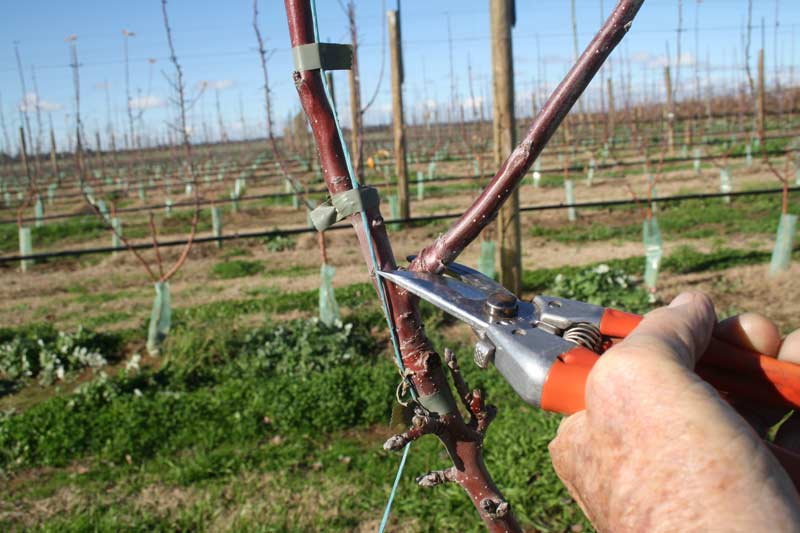The objective of this trial was to observe from planting, the influence of different tree training methods on the performance of young Aztec Fuji trees.
Young tree growth trial (cont from last issue)
The objective of this trial was to observe from planting, the influence of different tree training methods on the performance of young Aztec Fuji trees.
Four replicates of six different tree training methods were used to establish Aztec Fuji trees on M.26 rootstocks.
Trees were planted in 2014 at a spacing of 3.5m x 1m. The six treatments were:
planted as received from the nursery, with no limb removal or adjustment
at planting—all side limbs removed (whipped), with no heading
at planting—all side limbs removed (whipped), no heading, re-whipped second season
at planting—all side limbs removed (whipped) and headed at 900 mm
at planting—all side limbs removed, headed at 900 mm, re-whipped second season
at planting—all side limbs removed, headed at 900 mm, no limbs allowed to develop below heading height.
The orchard was netted in 2017 to protect it from hail and birds.
Results
Measurements from 2017 to 2020 showed that the two treatments of whipped and headed with no low feathers, and double whipped had the highest cumulative yields.
Comparatively, trees that had no treatment had the lowest cumulative yields.
Data collected in 2017 showed that the three worst performing treatments had the highest yield in that first fruiting season.
The highest early yielding treatments also developed a biennial bearing pattern in subsequent years.
Young tree growth is critical
The trial clearly shows that young tree growth is critical and should not be compromised by early crop loads.
The best performing treatments delayed early yields, with an emphasis on achieving early tree growth. Setting up the tree early, more than compensated in subsequent seasons, with significantly higher cumulative yields achieved.
Leader management trial
This trial is investigating the impact of different pruning strategies on leader growth of mature Rosy Glow trees.
The trial was set up in a mature, high density planting of Rosy Glow yielding approximately 100 t/ha per year.
Trees were pruned by the grower in accordance with their normal pruning practices, except for the leader.
Leaders were pruned according to the following different techniques and timings:
‘click’ pruning—leaders cut back to 3–4 buds above the most recent growth ring (winter pruned).
Summer pruned to weaker horizontal branch at summer solstice.
Leaders pruned to a weaker shoot as a replacement leader (grower’s own practice).
Leaders cut back to smaller horizontal fruiting branch (terminal bud) at desired height (winter pruned).
Leaders cut back to 3–4 buds above the most recent growth ring and NAA applied (winter pruned, grower’s own practice).
Winter pruned, NAA applied, root pruned and girdled (grower’s option)
Leaders pruned at full bloom.
Leaders pruned after harvest.
Results
There was some considerable variation in vertical shoot growth between treatments.
The summer cut treatment (undertaken at around summer solstice time) had the least number of vertical shoots.
The winter pruned with NAA, root pruning and girdling ('the works') had the next least number of vertical shoots. Whilst comparatively effective, “the works” is also a more expensive option.
Overall, the summer pruning treatment appeared to be the most cost-effective way of managing leader growth in a height restricted system. It had the least number of shoots, the shortest shoots and the highest proportion of shoots that did not need pruning.
See this article in Tree Fruit July 2021
This article is reproduced with permission and thanks, from Around the Orchard, a newsletter of the Apple and Pear, and the Cherry growers associations of South Australia.
Visit www.apgasa.com






















